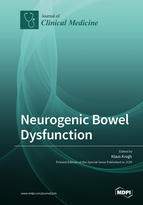Neurogenic Bowel Dysfunction
A special issue of Journal of Clinical Medicine (ISSN 2077-0383). This special issue belongs to the section "Gastroenterology & Hepatopancreatobiliary Medicine".
Deadline for manuscript submissions: closed (28 February 2021) | Viewed by 60662
Special Issue Editor
Interests: neurogenic bowel dysfunction; gastrointestinal motility; inflammatory bowel disease; methods for the assessment of gastrointestinal function
Special Issues, Collections and Topics in MDPI journals
Special Issue Information
Dear Colleagues,
Most disorders within the central or autonomic nerve systems cause gastrointestinal symptoms. The term neurogenic bowel dysfunction (NBD) is commonly used to describe the characteristic combination of constipation, difficult evacuation, and fecal incontinence experienced by persons with spinal cord injury, multiple sclerosis, or spina bifida. Patients with Parkinson´s disease have panenteric involvement and a clinically unique presentation of gastrointestinal symptoms. Likewise, patients with diabetic neuropathy have symptoms significantly different from those of other patient groups with NBD.
The total number of patients with NBD is very large and the symptom complex has severe consequences for social activities and quality of life of those affected. Despite the improved knowledge achieved within the last decades, the treatment of NBD remains a major clinical challenge. Treatment modalities for NBD have improved significantly but, unfortunately, this is not yet fully reflected in clinical practice. Better diagnostic tools and simple screening instruments for NBD are needed and the effects of NBD on other organ systems remain obscure.
The present Special Issue will include clinically oriented reviews and original papers on the prevalence, pathophysiology, current, and future diagnostic tools, as well as established and upcoming treatments for NBD.
Prof. Dr. Klaus Krogh
Guest Editor
Manuscript Submission Information
Manuscripts should be submitted online at www.mdpi.com by registering and logging in to this website. Once you are registered, click here to go to the submission form. Manuscripts can be submitted until the deadline. All submissions that pass pre-check are peer-reviewed. Accepted papers will be published continuously in the journal (as soon as accepted) and will be listed together on the special issue website. Research articles, review articles as well as short communications are invited. For planned papers, a title and short abstract (about 100 words) can be sent to the Editorial Office for announcement on this website.
Submitted manuscripts should not have been published previously, nor be under consideration for publication elsewhere (except conference proceedings papers). All manuscripts are thoroughly refereed through a single-blind peer-review process. A guide for authors and other relevant information for submission of manuscripts is available on the Instructions for Authors page. Journal of Clinical Medicine is an international peer-reviewed open access semimonthly journal published by MDPI.
Please visit the Instructions for Authors page before submitting a manuscript. The Article Processing Charge (APC) for publication in this open access journal is 2600 CHF (Swiss Francs). Submitted papers should be well formatted and use good English. Authors may use MDPI's English editing service prior to publication or during author revisions.
Keywords
- Neurogenic bowel dysfunction
- spinal cord injury
- multiple sclerosis
- Parkinson’s disease
- diabetic neuropathy
- constipation
- diarrhea
- fecal incontinence
- transanal irrigation
- neuromodulation







